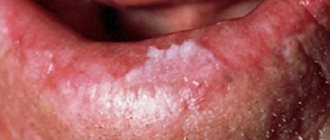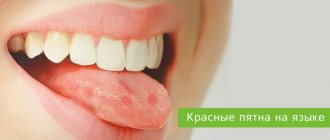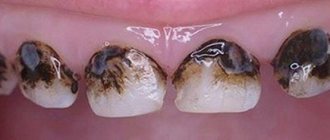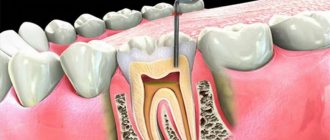Sometimes you can notice chalky-colored stains on your teeth. There can be many reasons for this. And they are all different. Chalky spots usually appear on those areas of the enamel where their mineralization is impaired.
If they are formed due to improper dental hygiene or stains occur due to an unbalanced diet, then such stains can be eliminated with the help of whitening pastes that do not contain fluoride. White spots may appear if tooth enamel begins to flake off.
The disease can develop on one tooth or affect the teeth of the entire dentition. Another cause of chalky spots is fluorosis, in which large amounts of fluoride compounds accumulate in the body.
What is white spot caries?
White caries on teeth is the common name for the early stage of the carious process. Based on the depth of dental damage, caries is usually classified into four groups:
- Caries in the spot stage (first white, then dark).
The enamel begins to lose minerals, and the area of demineralization acquires a pronounced chalky or white tint. Gradually this area darkens and becomes rough.
- Superficial caries.
It occurs after the dark spot stage and is expressed by the formation of a carious cavity within the enamel. At this stage, the patient may complain of minor pain when in contact with hot and cold, and the tooth may react to sour or sweet foods.
- Average caries.
The carious process spreads deep into the tooth, affecting dentin - the bone tissue located under the enamel. Painful sensations may be longer and more pronounced. Most often, at this stage, the patient no longer doubts that he has caries and turns to the dentist.
- Deep caries.
The stage when the carious cavity is in close proximity to the dental nerve. From deep caries to pulpitis - one step.
From the classification it is clear that caries in the white spot stage essentially represents the very beginning of the carious process. If the disease is diagnosed at this stage, caries can be cured even without drilling the tooth.
What symptoms indicate caries in the spot stage?
It is very difficult to suspect caries at an early stage. The patient has no complaints of pain, discomfort while eating, and in fact, white spots are the only thing that indicates the beginning of the carious process. However, white spots are also characteristic of a number of other dental diseases, so the dentist’s goal is to correctly determine the cause.
The following signs help distinguish caries from other dental diseases:
- a white carious spot is usually a single one, whereas in other diseases the lightened areas are located on many teeth;
- A carious spot is white or cream-colored; it does not have clearly defined boundaries and has a smooth matte structure. In other pathologies, the spots most often have a clear border and yellowish pigmentation;
- caries in the spot stage most often forms on healthy enamel, while in other pathologies the tooth may already erupt with white spots.
It is almost impossible to distinguish between caries and other dental pathologies by symptoms without the help of a doctor. Moreover, not everyone is able to independently notice the change in enamel color. Therefore, it is recommended to undergo routine examinations at the dental clinic twice a year.
Black spots
Tooth degradation of this nature can have several causes. One of them is Priestley's plaque , most often caused by disturbances in the microflora of the children's intestines. As a result, both baby and molar teeth are destroyed by bacteria. The disease can only be treated with medication.
Black spots can also be caused by the development of caries. Blackening of teeth is often a consequence of a lack of calcium in the body. For prevention, you need to reduce the amount of sweets you consume.
In addition, you can increase calcium levels by giving your child more milk and using vitamin complexes prescribed by your dentist.
Much less often, but still possible, this pathology can be inherited from parents. Therefore, the child must have personal cutlery (at least a spoon and fork).
How is caries diagnosed?
The difficulty in diagnosing caries at an early stage is that the tooth does not cause any concern to the patient. At a dentist’s appointment, the diagnosis is made after a series of standard studies:
- Visual examination is the main diagnostic method by which an experienced dentist can immediately determine whether a patient has caries and how it can be treated.
- Drying of enamel. Another diagnostic method, the essence of which is that matte areas are more visible on dried enamel, which may indicate the initial stage of the carious process.
- Probing, that is, examining the surface of the teeth with a dental probe, helps to identify roughness and softened tissue that may be a sign of dental disease.
- Staining the surface of tooth enamel. To diagnose caries in the staining stage, teeth are sometimes stained with special dyes (for example, methylene blue). It leaves no marks on healthy enamel, but slightly stains carious spots.
After diagnosis, the dentist determines the appropriate treatment method for dental caries.
Disease prevention
- Carefully perform hygienic procedures for caring for teeth and oral cavity.
- Follow a diet that contains a balance of animal and plant foods rich in vitamins and minerals.
- Avoid consumption of sweet confectionery products and sweet carbonated water.
- Take a multivitamin complex.
- Get your teeth checked regularly by your dentist.
If you find chalky stains on your teeth, you must make an appointment with a dentist, who will help determine the nature of such stains and give recommendations and prescribe a course of treatment.
Features of the treatment of caries in the form of a white spot
White spots, as a rule, are areas of demineralization of the enamel and are not accompanied by the formation of holes in the teeth - the so-called carious cavities. If there is no hole, the tooth can be treated in a minimally or non-invasive way - without preparation, drilling or further filling. This is the main advantage of early diagnosis: treating caries at the spot stage is not painful or scary.
There are several methods of non-invasive treatment of early caries that are used for both children and adults. These include:
- remotherapy;
- fluoridation;
- ozone therapy;
- infiltration treatment.
Let's talk in more detail about each method.
Main symptoms of various diseases
It is necessary to distinguish between the signs of different diseases:
- with caries, there is usually only one spot, but its location can be different - on the incisors, molars, on the chewing or frontal surface, as well as on the neck of the tooth, near the gums. At first, the area of demineralization is smooth and shiny, then it becomes matte and rough, and then darkens, expands and deepens,
- with fluorosis, whitish and yellowish streaks and stripes appear on all anterior crowns,
- with hypoplasia, defects are diagnosed in childhood, when the child’s primary or permanent elements are growing: with this disease, paired incisors or canines are often affected,
- in case of enamel trauma, areas of demineralization appear after wearing orthodontic or orthopedic devices and only where there was a mechanical effect of fasteners, hooks and other elements on the crown.
Remineralizing therapy
White spots during caries are areas of enamel demineralization. It is possible to remove them if you restore the balance of minerals in tooth enamel. This can be done with the help of remineralizing therapy. It can be applied or carried out using a special mouth guard. In the first case, the tooth surface is covered with a concentrate for remineralization, in the second, a sealed mouth guard is used, individually made from a jaw cast. As prescribed by the doctor, the patient himself will fill the mouthguard with a remineralizing composition and put it on his teeth. Most often, solutions of calcium gluconate or glycerophosphate, as well as gels with calcium phosphate, are used for remotherapy.
Remotherapy helps remove caries in the form of stains, helps strengthen tooth enamel, replenishes the lack of minerals (mainly phosphates and calcium), reduces tooth sensitivity, prevents further development of the carious process, and preserves the natural healthy appearance of teeth.
How does fluoridation treat caries in the spot stage?
The method helps provide the enamel with a sufficient amount of fluoride, a substance that maintains its strength and durability. The simple fluoridation method will require from 4 to 15 procedures. During each procedure, tooth enamel is coated with fluoride gel or varnish and left for 20 minutes. You must not eat or drink for 60 minutes after each procedure.
Deep fluoridation is considered more effective. To carry it out, you will need two drugs: a composition with fluorine, magnesium, copper and calcium hydroxide. When both compounds react, crystals are formed that seal the enamel structure. Thanks to the procedure, the concentration of fluoride ions in teeth increases approximately 5 times. Deep fluoridation is performed in one, less often - in 2-3 procedures.
With the help of fluoridation, enamel becomes more resistant to the destructive effects of organic acids, the activity of plaque bacteria and, accordingly, the rate of caries development is reduced, the healthy mineral composition of the enamel and the normal structure of hard tooth tissues are restored.
Often, when treating dental caries in the staining stage, methods of remotherapy and deep fluoridation are combined to achieve the best result.
Therapy and restoration work for enamel hypoplasia
Treatment for this disease is ambiguous and requires a detailed study of the clinical picture. In mild cases, you can get rid of the defect by grinding off the top layer of enamel and remineralizing it, but some situations require more labor-intensive and multi-stage treatment - taking medications, strengthening hard tissues, strengthening the immune system. Aesthetic defects can also be eliminated using whitening, filling with composite materials, prosthetics with veneers and crowns.
ICON caries treatment method
A relatively new method of caries treatment, ICON, is used in adults and children from three years of age. An important condition is that the patient can sit quietly in the dental chair for at least half an hour. Like other minimally invasive treatments, it is only effective at an early stage.
ICON technology was developed in Germany, certified in Europe, and has been successfully used for many years in various European countries. Today this method is gaining popularity in Russia. Tooth enamel has a porous structure, which allows bacteria to penetrate into the pores and, with the help of acid, have a destructive effect on the teeth.
The infiltration method of treatment involves the dentist treating white spots on the enamel with a special sealant, which seals the pores of the enamel and prevents bacteria from further destroying dental tissue.
The infiltration method in our country is used as an alternative to deep fluoridation. It is painless, does not require deep intervention in the tooth tissue, is carried out in one procedure, and gives an effective result in stopping the carious process.
Treatment is carried out in several stages. First, the teeth are cleaned of plaque and tartar, after which the affected area is treated with an acid-based etching gel. This drug affects only the affected tooth tissue.
The second stage involves drying the surface of the tooth enamel, and the final stage involves treating it with an infiltrating drug. This composition acts as a sealant, closes pores and protects tooth enamel from bacteria.
Ozone therapy in the complex treatment of caries
This method is rarely used on its own; more often it is used in the complex treatment of caries at the white spot stage. The dentist treats tooth enamel with ozone, which has an antimicrobial effect. The disinfecting effect of ozone helps stop the spread of bacteria, after which remineralization or deep fluoridation is carried out to restore the mineral composition of the enamel.
The dentist determines how to treat carious white spots on the enamel based on the patient’s age, medical history and other factors.
Brown spots
Similar manifestations on tooth enamel are also caused by the development of hypoplasia. The disease is generally very common and, according to some estimates, affects up to 40% of children.
The causes of hypoplasia, in contrast to caries, which destroys still growing teeth, are complications during pregnancy or trauma during birth. It can also develop due to poor nutrition, digestive problems and damage to tooth enamel.
For prevention, it is necessary to monitor the condition of the mother’s teeth. You should stop artificial feeding and monitor the child’s nutrition subsequently, as well as regularly visit the dentist.
Other causes of white spots on teeth
White spots on teeth are not always caries. There are a number of other reasons that lead to their appearance.
- Traces from braces.
Sometimes white or dark spots remain on the teeth after braces are removed. This is due to the fact that in the area where the locks adhere to the teeth, demineralization of the enamel occurs. Sometimes a white area under the brace lock can be a result of poor oral hygiene.
- Fluorosis.
The appearance of white or yellowish spots on the teeth may be due to an excess of fluoride in the body and the development of a disease such as fluorosis. It often occurs on children's teeth even before teething. As a result, the child’s teeth erupt immediately with white spots on the enamel.
- Hypoplasia of tooth enamel.
This is a pathology in which there are obvious disturbances in the normal development of the tooth. For example, with hypoplasia, natural grooves on the teeth may not form or there may be partial underdevelopment of the dental crown. One of the characteristic signs of hypoplasia is areas on the teeth in the form of a white spot.
It is difficult to understand on your own what caused the stains on your teeth; you should definitely consult a dentist. If this is caries in the white spot stage, it is necessary to begin treatment immediately, before the process spreads to deep tissues and leads to the formation of a carious cavity.
Diagnostics
Doctors do not recommend that parents do anything on their own. After all, spotting is a symptom of completely different diseases. You should contact a dentist who will conduct research and establish the correct diagnosis. To begin with, a visual examination of the oral cavity is performed. Then the dentist questions the parents in detail, collecting anamnesis. If there are indications, the child is sent for x-rays and other instrumental research technologies. If necessary, consultations with narrow specialists are provided. In addition to the pediatrician, the baby can be examined by an endocrinologist, immunologist, gastroenterologist, infectious disease specialist and other specialists.










